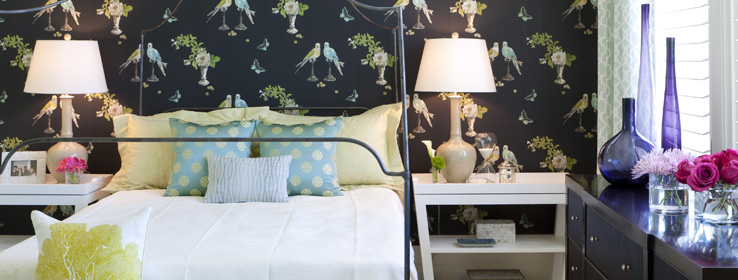BY KELLEY STRATTON
Kelley ponders the question: Does location affect a client's color and design aesthetic?
I've always wondered if regional differences in styles and color trends exist beyond the stereotypes perpetuated by the media. House Beautiful magazine recently conducted a nationwide poll that concluded color choices really do vary by region. Here are the favorite colors of various U.S. regions, along with my suggestion of an accompanying Sherwin-Williams hue:
(To see how these colors match up against interior designer Lauren Makk‘s take on regional color trends, read the story.) While color preference may be driven by location, an overall style aesthetic may not. For example, Los Angeles−based designer Julie Garner, owner of Julie Garner Interiors, finds her clients are more influenced by the architectural style of their home than its physical location.
"I see a trend when it comes to architectural styles and color selection. For many of the Tuscan-style homes I've designed, my clients gravitate to the warm creams, terra cottas, browns, greens and golds, while those who own more modern or transitional homes tend to prefer cool neutrals."
Even so, you could still say there's a regional style influence at work here, given you're less likely to see Tuscan-inspired architecture in a city like Chicago or Omaha than in a city like L.A.
Natural light is one of the most important factors in interior design, and something many clients don't consider when selecting colors. I've had many clients expect a single color to work throughout an entire space, and be surprised when I advise otherwise. I always tell my clients to tape up large paint samples — like the ones from Sherwin-Williams that come in two sizes: 4-1/4" x 3-5/8" and 8-1/2" x 11" — in various locations throughout a space to see how light affects the color during different times of the day and night, as well as in different weather conditions.
This is especially important in some regions of the country. For example, in the northern U.S., the four to six months of winter mean short days and long, dark nights. I speak from personal experience, having relocated five years ago from sunny San Diego to not-so-sunny Seattle. Not surprisingly, residents of the Pacific Northwest tend to want a lighter color palette for their interiors. To quote my own husband, "When it's already dark outside at 5 p.m., the last thing I want to come home to is a dark room. It's depressing. I want as much light as I can possibly get."
What about those, like myself, who relocate from one region to another? Do they want to keep their old design aesthetic or change it up to something more suited to their new environment? Or does location matter at all in terms of style?
Designer Jessica De Kler, founder and principal designer at Deakins Design Group in Brooklyn, N.Y., recently completed a project for a Maine-based couple with a second home in Florida. She knew their Maine residence was designed in the traditional New England style. "And while they wanted something different for their second home, they were adamant about staying away from the Mediterranean and Italianate styles so common in Florida," says De Kler. "She used the word ‘zen' a lot."
De Kler was careful not to go too modern or too Arts and Crafts. "We ended up with a design that feels warm, thanks to traditional Asian elements, but also feels modern because of the clean, unfussy details." The colors used throughout the home are softer, more tranquil versions of the colors used in the Maine home. Walls paneled in a warm gray, trimmed with crisp white and balanced with dark hardwood floors create a contemporary yet inviting feel. Color was injected strategically — as in the traditional Asian sideboard painted in red lacquer.
When the project was finished, De Kler heard from the couple's daughter. "She gave me the best compliment. She told me the Florida house was the ‘alter-ego' version of their home in Maine. That's when I knew I'd accomplished my goal — I'd given my clients a completely different look, yet one they'd feel comfortable with."
So to answer my own question about regional styles, I suppose the answer is both yes and no. While there are important factors to consider when designing a project in a particular region of the country, such as weather, seasons (and length of seasons), exterior colors and natural light, I haven't found that many rigid regional styles. Because in the end, no matter where your client heralds from, color and design choices are all about personal preference.
photo by Ed Chapell





